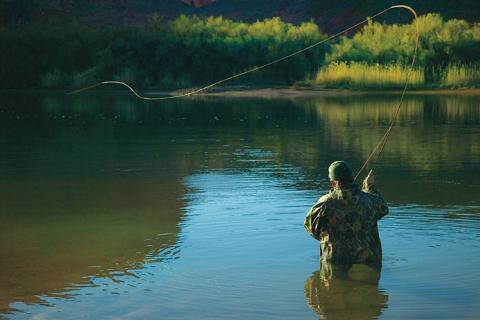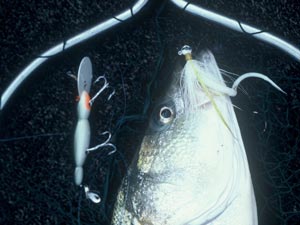
Sculling gently with a small wooden paddle, the angler eased his Sneak boat up to a flooded bridge piling in Santee-Cooper as travelers sped past overhead on Interstate 95. Reaching out with the 9-foot graphite fly rod, he dropped a pair of jigs next to a concrete column and soon felt stiff resistance and solid bucking on the line. As he worked the unseen quarry gradually to the surface, not one, but a pair of 1 1/2-pound crappies came flopping aboard the one-man fishing craft.
 |
| Bobby Tindal, creat of the Sneak Boat, lands a double on crappies near a bridge piling on Santee Cooper in South Carolina. |
Bobby Tindal's tandem jig rig had scored a double.
As I watched that scene unfold a few years back from a Sneak boat of my own that Tindal had leant me, I quickly became a convert to fishing tandem rigs.
What could be better than a carefully-chosen lure presented at just the right depth and speed to draw a strike? Well, at times, two lures — a pair of offerings fished in tandem.
Multiple-lure rigs can be used to catch a variety of gamefish including bass, stripers, bluegills, crappies, pike, trout, walleyes, white bass, pickerel and many saltwater species. Granted, it can be a bit more of a hassle to assemble, cast and keep a pair of offerings untangled, but when rigged properly, tandem lures aren't that difficult to use and can often increase your catch significantly over single offerings. Sometimes, like Tindal, you might even catch two fish at once.
Why They Work
With multiple-lure rigs, you're giving the fish something they rarely see, which is always a plus in this age of heavy fishing pressure. At times you're also offering them a choice of two different shapes, colors, sizes or actions of lures — a small jig, for instance, and a large plug or spoon. The fact that you offer these two lures simultaneously doubles the efficiency of your fishing time.
You can also imitate realistic scenes in nature. If you choose similar-sized lures, presenting several offerings at once can simulate a school of forage fish. A large lure following a small one can represent a big baitfish chasing a little one.
Some tandem-lure setups work best for trolling, others can be cast or vertically jigged. Here are some of my favorite multiple-lure rigs, species they catch and how to use them.
Diving plug and jig
This is a great rig for striper trolling. A large, deep-diving plug like a Hellbender and Bomber Deep Long A attracts fish with its wobbling, "big baitfish" swagger, but also acts as a mini-downrigger, taking a small trailing jig deep. At times fish grab the large plug, but more often than not they nail the trailing jig.
How to Use It — Tie an 18- to 30-inch length of 20-25 pound line to the center hook of the front treble on the plug and attach a one-quarter ounce white or chartreuse bucktail jig to the end of this leader. Alternately, you can tie in a three-way swivel 24-36 inches ahead of the diving lure and attach a jig on a 12-inch dropper from this, so it runs in front of the larger plug. Troll over points, humps, channel edges and places where fish or bait show on the depth finder. Using slightly smaller plugs and lighter (one-eight ounce) jigs, this rig also scores on big walleyes, smallmouths and white bass.
Double jigs or darts
A jig is a great fish producer for many species, but sometimes two rigged in tandem work even better. The greater weight lets you cast farther and gets the offering deep quickly without resorting to a larger lure, which sometimes turns off skittish fish.
 |
| A huge striper fell for this trolled Hellbender and trailing jig tandem offering. |
Whether you're dapping in shallow, flooded timber or jiggling a pair of leadheads 18 feet deep next to a bridge piling, two crappie jigs are often better than one. Similarly, when casting darts (small, angular jigs) for shad in East and West Coast rivers, I find using a pair is often more productive than one.
How to Use It — Tie in one jig, then slide the knot forward on the eyelet. Tie in a 12- to 24-inch piece of line behind the knot and attach the second lure to that. As an alternate rigging you can use a three-way swivel with two leaders coming off it, or tie a loop 18 inches from the end of the line and attach the extra jig to that. White bass, smallmouths, bluegills and walleyes also like this rig.
Tandem topwater lures
Fishing two surface plugs makes it look like the one in front is trying to escape the one behind it. Or it might appear like a school of fish skimming across the surface. Whatever they think it looks like, it's usually too tempting for most bass to resist.
How to Use It — A variety of small topwater lures or thin-minnow plugs can be used in front of a larger surface lure. Remove either both treble hooks or just the back one from the front lure and tie the second plug to a trailing 18- to 24-inch leader attached to the rear eyelet.
Spoon and grub
A weedless spoon snaking through mats of hydrilla or lily pads can entice smashing takes from pike, pickerel and bass. But other times you might see swirls or feel a bump with no solid hookup. That's when it's time to add a trailing grub.
How to Use It — Tie an 18-inch leader to the eyelet of the spoon or the bend of the hook and attach a grub to it. This will pick up fish that are attracted to the big, flashing lure, but wary about striking it. Alternate rig: use a non-weedless spoon and trailing jig for white bass and hybrids when they're crashing into bait on the surface.
Double Carolina Rig
A large plastic lizard, crayfish or worm fished Carolina-style is effective on aggressive bass. To pick up followers and skittish fish, though, try this rigging.
How to Use It — Attach a three-way swivel instead of a barrel swivel behind a sliding 1/4- to 3/4-ounce weight, then add two leaders — one 4-6 inches, one 2-3 feet. Rig a small grub on a plain hook to the short dropper, a larger lizard, worm or crayfish to the longer leader. Use this offering to probe weeds, brush, flooded timber and deep structure with a slow, steady retrieve or pull-and-pause motion. This rig can attract very big fish, so go with stout line.
A Pair of Flukes
Another variation of this method described above involves using two Flukes or similar soft plastic lures fished off of a three-way swivel with no weight.
How to Use It — Cast and retrieve it with pauses and twitches near points and cover or where you see breaking fish. Work it within a foot or two of the top in an erratic motion. The pair of soft plastic offerings provides extra weight so you can cast a long ways and cover lots of water with this technique.
No one would want to fish with tandem rigs every day, but a few double lure combos should be in every angler's bag of tricks for those times when your normal offerings aren't doing the trick.
Alabama Rigs
One of the most productive lures for saltwater anglers seeking huge striped bass along the East Coast is an offering that takes the multiple-lure concept to the limit. It's called the umbrella rig and is also used in some large impoundments for freshwater stripers.
It consists of a heavy lead jighead at a central connecting point with five or more metal side arms coming off like spokes at about a 45-degree angle. A soft plastic shad lure on a jig head is attached to each of these arms.
Experimenting with and redesigning this rig, led Andy Poss to create a similar offering that could be cast for black bass in freshwater, dubbed the "Alabama Rig." In short order, this cumbersome rig has become one of the most deadly offerings for largemouths on the modern bass fishing scene. Several companies now make lures similar to this, such as the Bass Pro Shops Deadly 5 Crappie Rig and the Mann's Alabama Rig.
Not only are doubles possible with this hefty umbrella rig, some anglers have caught up to five bass at one time as a school of fish sees what looks like a pack of baitfish and attacks in a group. Your arm may get tired pitching this heavy collection of lures, but it might be worth the price if you catch a limit in just a cast or two!
*There are a few states where this multiple-hook umbrella-type rig is illegal, so check your local regulations before using it.
- 11135 views

